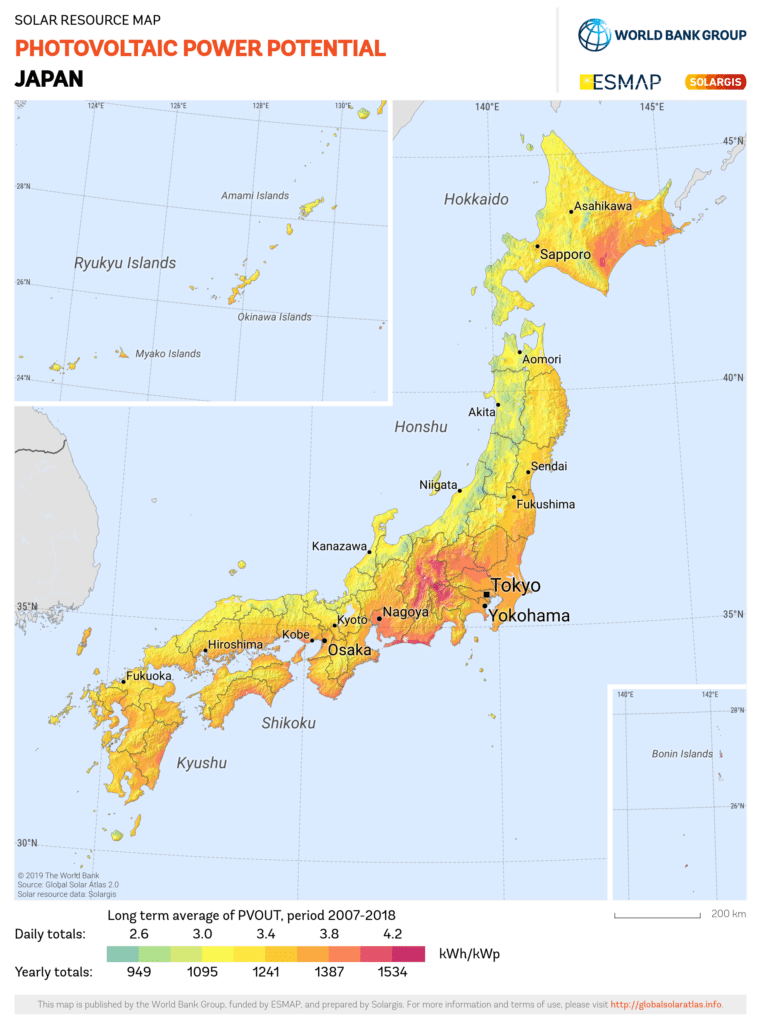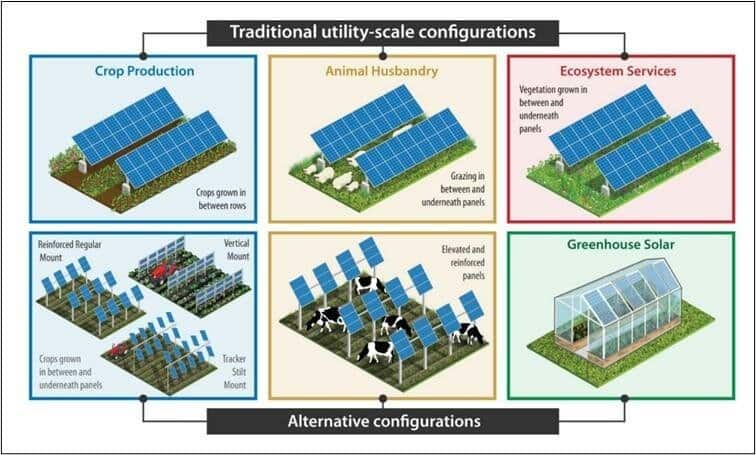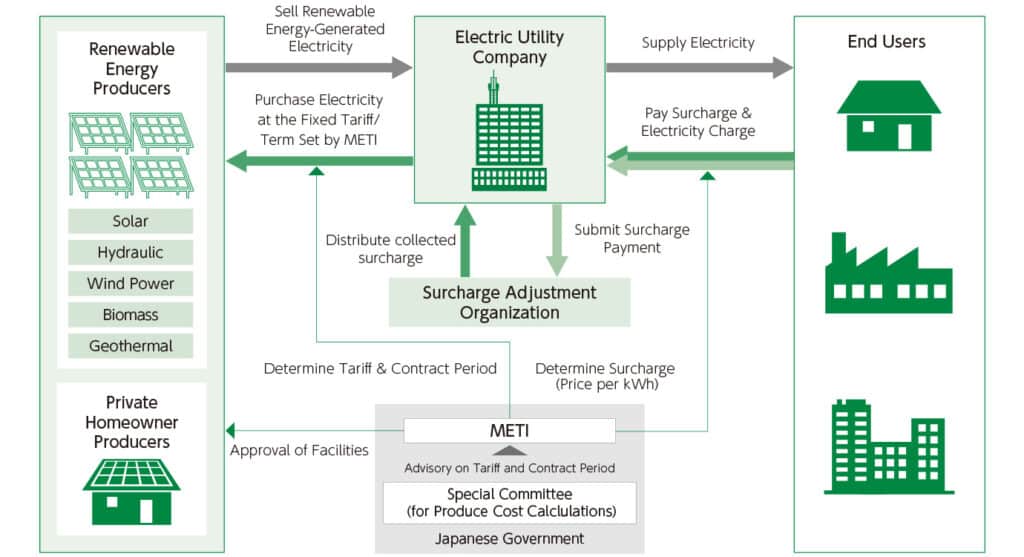Solar Energy in Japan: Room For Growth
Source: Laketricity
11 April 2024 – by Eric Koons Comments (0)
Solar energy in Japan is emerging as a cornerstone of Japan’s strategy to meet its ambitious long-term sustainability goals. The Sixth Strategic Energy Plan aims for carbon neutrality by 2050 with an interim goal of 36-38% of energy from renewables by 2030. This underlines a significant shift towards renewable energy, with a majority coming from solar power generation.
Potential of Solar Power in Japan
This goal reflects Japan’s acknowledgement of its significant solar energy potential, which is enough to produce four times the country’s current energy needs through PV system projects, including rooftops solar panels, floating and others in conjunction with agriculture. Furthermore, the country’s population is in decline, which will free up an additional 8,000 square km of agricultural land – an ideal amount for utility-scale solar facilities.

How Much of Japan’s Energy Comes From Solar?
In 2022, solar energy accounted for 5.39% of Japan’s total energy mix and 9.91% of its electricity generation. In both cases, solar power in Japan holds the largest share of all renewable sources. This is a drastic contrast to even a decade ago when solar energy contributed less than 1% of the country’s energy. In total, solar energy in Japan grew from 11.05 TWh in 2010 to over 260 TWh in 2022.
However, even with this shift, the country must dramatically increase its solar energy infrastructure to meet its 2030 and 2050 targets. In 2022, Japan produced 4,956 TWh of energy. Assuming energy consumption remains relatively stable, renewable energy capacity will need to grow to 1,784 TWh by 2030. This growth relies on better government policy to incentivise renewable energy and grid infrastructure investment.
Why Is Solar Power So Popular in Japan?
The steady growth of solar power in Japan is attributed to several factors, including the country’s focus on energy security, economic efficiency and environmental sustainability. Post-Fukushima, there was a national reevaluation of energy sources. Where nuclear power once previously accounted for around 13% of the country’s energy, within a year that dropped to less than 1%. This gap was filled with a mix of renewables and fossil fuels, coinciding with the growth of solar energy in the country.
Solar energy in Japan, with its relative ease of installation and support through governmental policies, such as generous feed-in tariffs, emerged as a popular choice. This allowed individual consumers to economically invest in residential solar arrays, while developers constructed large utility-scale facilities.
Agrivoltaics and Floating Solar Power Plants
Moreover, initiatives like agrivoltaics and floating solar power plants are becoming more popular, allowing the country to capitalise on a growing portion of its potential solar capacity. Japan is home to over 50 of the world’s 100 largest floating solar facilities and around 2,000 agrivoltaic farms.

What Is Japan’s Solar Energy Policy?
Japan’s renewable energy policy is primarily encapsulated in the country’s Sixth Strategic Energy Plan, which was released in 2021. It is the country’s basic guideline for medium to long-term energy policy. The plan is updated every three to four years to align with the changing regional and global energy landscape. The plan calls for maximising the development of renewable energy infrastructure in harmony with local communities.
The Japanese government has introduced several specialised programs to facilitate this growth. One of the key existing programs is the feed-in tariff, which guarantees the purchase of electricity from a new solar energy facility at a set price for a number of years. This lets developers know they will recoup a significant portion of the upfront construction costs, lowering overall risk.

Another major step is the announcement of a national carbon pricing system that will come online in 2028. The system will tax fossil fuel importers, disincentivising fossil fuel use in favour of domestic low-carbon options.
Existing Policies Cast Doubt on the Energy Transition
Overall, the growth potential for Japan’s solar energy sector is immense, which will help spur the country’s domestic PV industry. Forecasts suggest the solar energy market will see a compound annual growth rate of 9.2% until 2029.
However, there are many doubts about whether the existing policies and predicted growth will be enough to meet the country’s 2030 and 2050 targets. Experts are concerned over the country’s “various pathways toward a common goal” of decarbonisation. This idea cites that Japan’s geographic constraints make it costly to develop large-scale renewables, and the country should aim to secure a supply of all energy – including fossil fuels. Rather than completely phasing out fossil fuels, the government is looking to find less carbon-intensive ways to keep using them.
This contradicts the idea of a green energy transition and relies on untested clean fossil fuel technologies. Furthermore, it means a significant amount of funding will go towards these clean fossil fuel technologies rather than renewables. The data shows that the country can meet its energy needs with renewable energy options, even if they are more expensive than other nations.
This approach will hinder the decarbonisation the country publicly states it is aiming for and needs reassessment. Decarbonisation is not compatible with fossil fuels – regardless of the technologies used.
by Eric Koons
Eric is a passionate environmental advocate that believes renewable energy is a key piece in meeting the world’s growing energy demands. He received an environmental science degree from the University of California and has worked to promote environmentally and socially sustainable practices since. Eric’s expertise extends across the environmental field, yet he maintains a strong focus on renewable energy. His work has been featured by leading environmental organizations, such as World Resources Institute and Hitachi ABB Power Grids.
Read more






